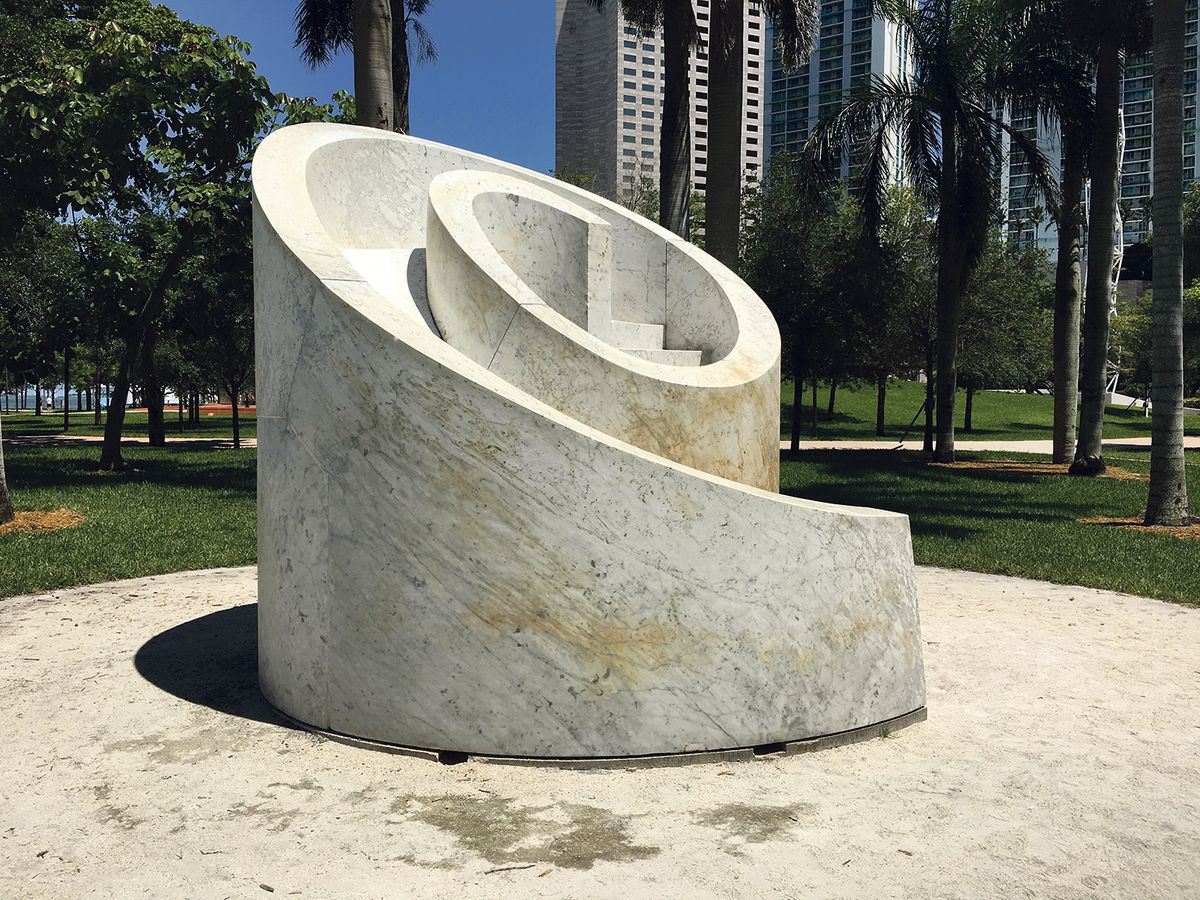Isamu Noguchi created Slide Mantra (1986) as the centrepiece of his solo exhibition in the US Pavilion at the 1986 Venice Biennale, the first edition of the event at which the Americans had devoted their space to a single artist. Noguchi constructed the monumental sculpture, which stands over 10ft high, out of seven interlocking components carved from 120 tonnes of Italian marble. After he redesigned Miami’s Bayfront Park in the mid-1980s, it also became Slide Mantra’s permanent home. (City officials originally approached him about simply adding a sculpture to the existing space, but his response, according to the Noguchi Museum’s archives, was: “No. Your park is terrible. You need a new park!”)
The sculpture’s formal elegance is only half the story. Noguchi had long been interested in expanding the medium’s possibilities beyond quiet contemplation into more tactile experiences, particularly play. To that end, Slide Mantra is in fact a functional slide for public use. Kan Yasuda, who assisted with its fabrication, recalled Noguchi repeatedly barrelling down the sculpture himself, then having its contours re-carved until he felt it had the right velocity—an indelible image of the famously fiery artist.
After enduring significant hurricane damage and untold amounts of graffiti in the years since its installation, Slide Mantra has been restored, reinforced and galvanised with a mark-resistant protective coating, ensuring that it can continue enchanting visitors for years to come. Shantelle Rodriguez, a Miami native and the director of experiential art centres for Superblue, extols its virtues for the uninitiated.

Shantelle Rodriguez has been sliding down Noguchi's sculpture since childhood Courtesy of Superblue
The Art Newspaper: What do you think makes Slide Mantra such a special part of Miami?
Shantelle Rodriguez: Honestly, for as long as I can recall, Noguchi’s Slide Mantra was a cherished fixture of Bayfront Park. At first I didn’t know what it was or who it was by, and a lot of other people who love it don’t, either. I appreciate it partly for that reason.
The way you first encountered the sculpture seems like the way Noguchi would have preferred: as an experience first, and as a work of art later.
My parents were Cuban immigrants who weren’t interested in art so much. I wasn’t going to museums as a child. Art didn’t come to me until later in my life.
When did you find out about the history of the sculpture?
I didn’t learn about it until my early years at Florida International University, where I got my bachelor’s in art history. We were studying how Miami got this work that came from the Biennale in Venice, and I was like, “Wow, this piece that I always loved has this incredible [pedigree].”
How did that knowledge change your perspective on the piece?
As my appreciation of art blossomed, this sculpture transformed into an object of admiration and pride. Today, many individuals would think, “Of course Miami would have this incredible piece; it’s an artistic hub!” But when I was growing up, Miami was lacking in cultural spaces and pieces. Wynwood wasn’t there yet. It was the type of place where you drive your car fast and don’t stop at traffic lights. Discovering later that all this time we had something as culturally significant as this slide by this remarkable artist in my hometown was eye-opening.
You enjoyed the slide as a kid. Have you introduced others to it as an adult?
I went down the slide as a child, and then later on with my nephew and godson, when he was younger. More recently, I went down it with my goddaughter; I have pictures of her on it.
It sounds like you’ve spent a lot of your life toggling between the art world and the rest of the world. Have you ever used Slide Mantra as an entryway to explain what you do for a living?
My whole career has been about democratising art and bringing it into public spaces. A lot of my non-art family have trouble understanding the relevance of pieces I show them, but Slide Mantra is something a lot of people can relate to, like the immersive installations we now have at Superblue. It’s a universal language. It’s a beautiful marble structure that can be admired, but it also has this playfulness to it—playfulness with a purpose.
• Slide Mantra by Isamu Noguchi, Bayfront Park, Miami


